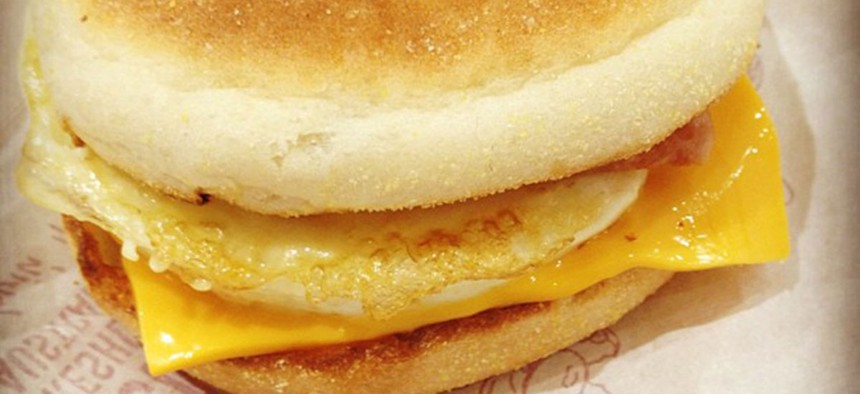
Flickr user Kae Yen Wong
How USDA Helped McDonald’s Climb Out of a Sales Rut
Like the new, buttery Egg McMuffins? Thank the government.
Last week, while basking in the glow of (finally!) having a positive sales quarter, McDonald’s CEO Steve Easterbrook noted that the growth was driven, at least in part, by a simple recipe change: putting butter, instead of margarine, back in Egg McMuffins.
“Customers appreciated the change and we saw a double-digit increase in the number of Egg McMuffins sold immediately following the rollout,” Easterbrook said during the investors’ call to discuss the earnings results.
McDonald’s switch will have a huge impact on the entire US dairy industry—and an organization controlled by the US Department of Agriculture (USDA) says it played a major role in making it happen.
It turns out that Egg McMuffins weren’t the only menu items that got a buttery makeover—19 other Mickey D’s products did too. McDonald’s will now add another five to six hundred million pounds of milk to its annual dairy purchases. Plus, because McDonald’s is a market leader, other chains are likely to follow suit, making the impact on US dairy even bigger.
This is great news for the struggling industry, which has watched fluid milk consumption drop every year between 1985 and 2014, even as dairy production has increased 44% in that period, according to USDA data.
A key player behind the scenes is Dairy Management, Inc., (DMI) which manages the National Dairy Promotion and Research Board, a so-calledfederal “checkoff” program, common in agriculture to promote the sale of specific commodities, in this case, dairy. Anyone who has seen a “Got Milk?” ad or heard the “Incredible Edible Egg” slogan is familiar with their work. These boards are funded by the industry but their activities are ultimately controlled by the US Department of Agriculture (USDA).
Developing partnerships with fast food companies is one way DMI promotes dairy and by its own account, it plays a critical role. “This change [at McDonald’s] wouldn’t happen if it weren’t for the checkoff, the farmers who fund it and the work of our national and local team members,” said Tom Gallagher, CEO of DMI.
In what DMI called a “model for other checkoff partnerships” in 2013, it placed staff members on site at McDonald’s headquarters to offer expertise in areas including food science, nutrition, schools and sustainability.
The relationship between the boards and the USDA is a touchy subject for the government, which works hard to disassociate itself from these organizations’ at times controversial activities. It often describes its role as merely ensuring legal compliance, instead of directing strategy or choosing business partners. In this case, the USDA acknowledged that its Agricultural Marketing Service “carries out the regulatory, day-to-day oversight” of programs like the National Dairy Promotion and Research Board, but it points out that the board is led and run by the industry. DMI told Quartz that it “is not a government agency,” noting that it is privately funded and run by dairy farmers and importers.
But the Secretary of Agriculture is required by law to approve “any promotion, research, or nutrition education plan or project,” and those projects can only become effective with that approval. As the Department of Justice wrote in a court brief in 2002, the notion that “government plays a role in the program that is limited to ‘administrative oversight’ should … be rejected.” Years later, in another checkoff case, the Supreme Court agreed with that argument, saying the message of the checkoff’s campaigns “is effectively controlled by the Federal Government itself.”
While the USDA would not comment specifically on its direct involvement in the McDonald’s partnership, attorney Matthew Penzer, who as special counsel to the Humane Society of the United States has trial experience in checkoff laws, tells Quartz that, the “USDA must approve all plans and projects of checkoff boards, so DMI’s pro-butter plans should be presented to and approved by USDA.”
It underscores the USDA’s inherent conflict of interests: It is simultaneously tasked with both regulating and promoting agricultural interests, as well as developing the US dietary guidelines (along with the Department of Health and Human Services) which shape many Americans’ diets and countless government food contracts, from schools to the military.
Health advocates question the government’s involvement in selling fast food. “By promoting the unhealthiest menu items at fast-food restaurants, the USDA contradicts the government’s own public health goals,” writes food lawyer Michele Simon in her 2014 report,Whitewashed: How Industry and Government Promote Dairy Junk Foods.
The USDA doesn’t see a conflict. A spokesperson told Quartz, “USDA encourages all Americans to eat a healthy, balanced diet—which includes servings of dairy.”
DMI counts a number of fast food achievements, both in the US and abroad. It has partnered with Domino’s, Pizza Hut, and Papa John’s to sell more than 100 million pounds of US cheese in the Pacific Rim. With products like the cheese-filled Cantina Double Steak Quesadilla, it helped Taco Bell use an additional 1.7 billion pounds of milk in 2013. These kinds of relationships at one point drove more than a billion pounds of dairy sales in a twelve month period.
McDonald’s did not respond to multiple requests for comment.
(Image via Flickr user Kae Yen Wong)






